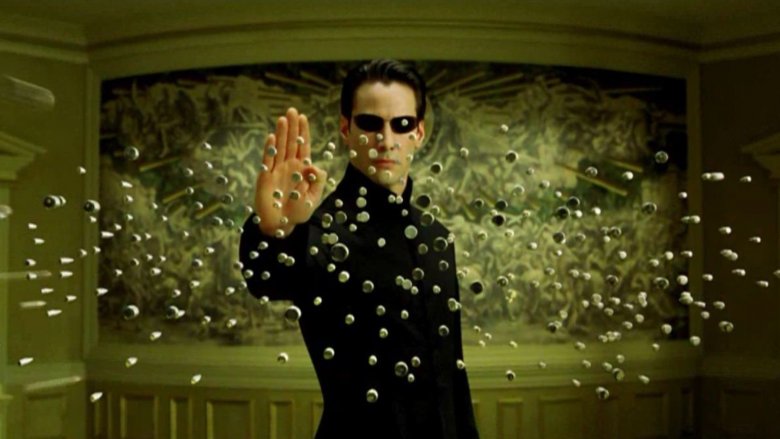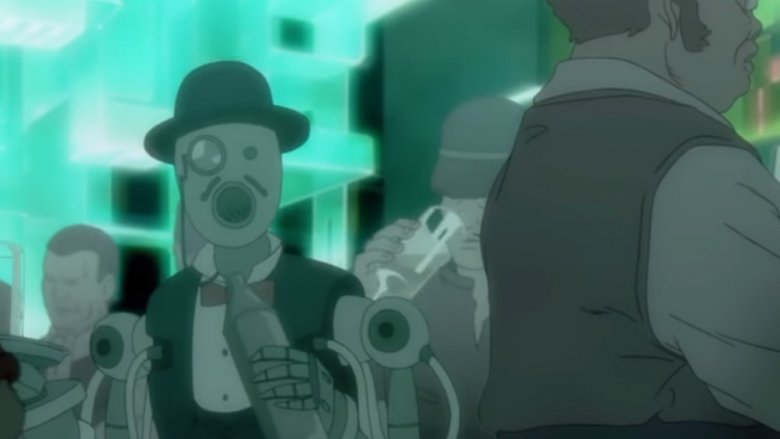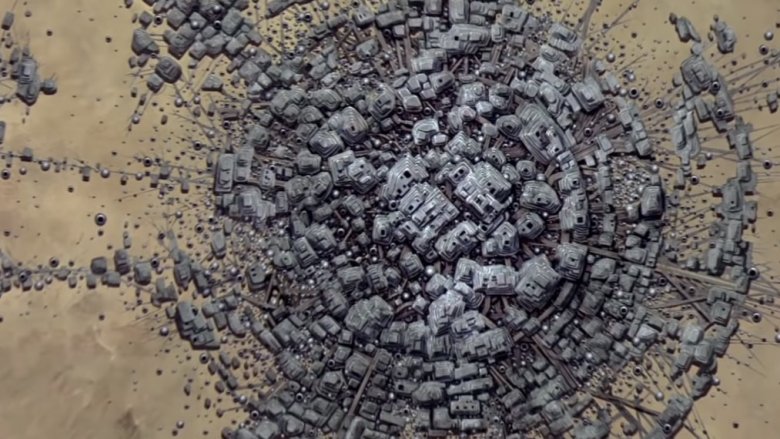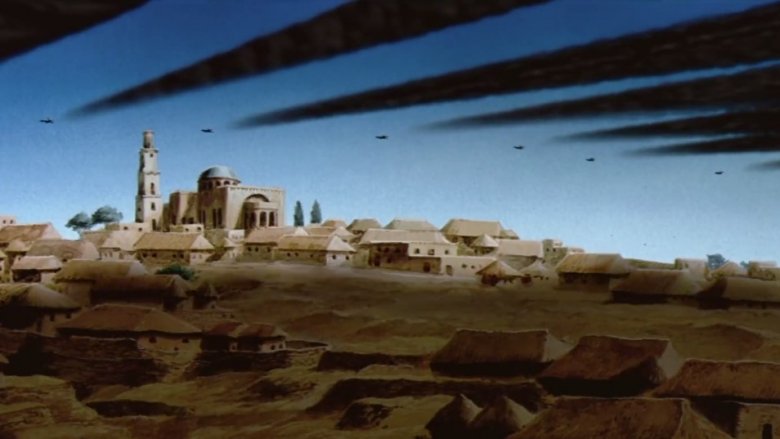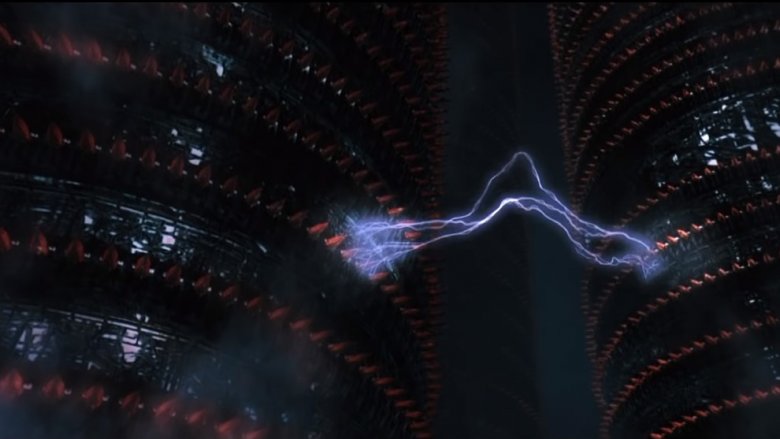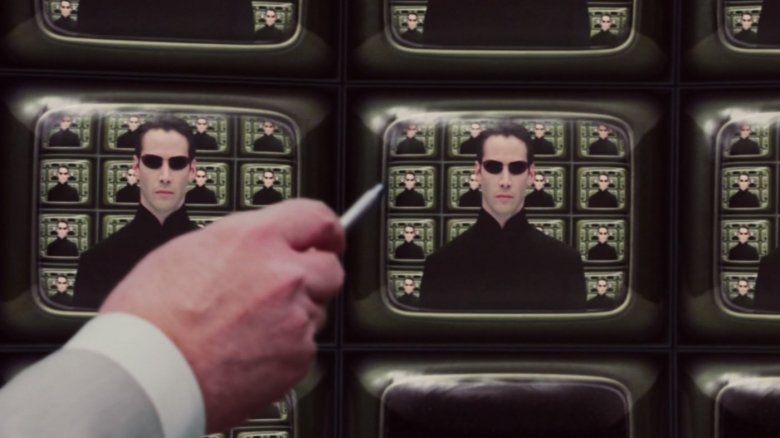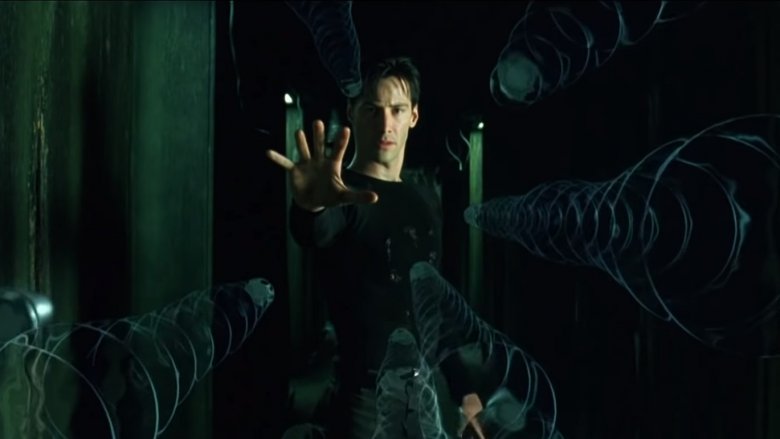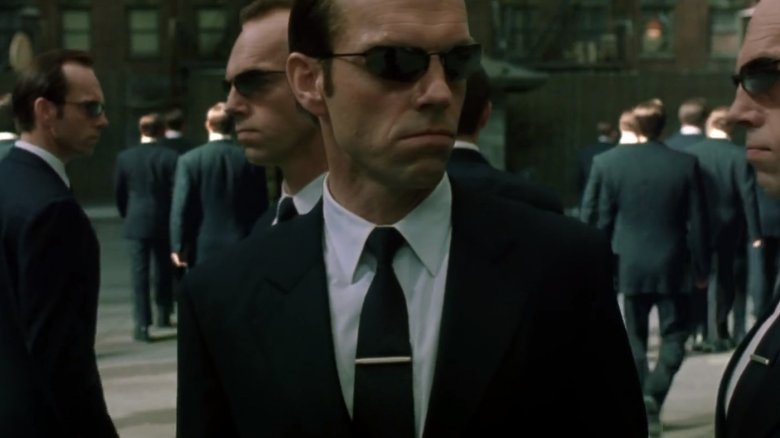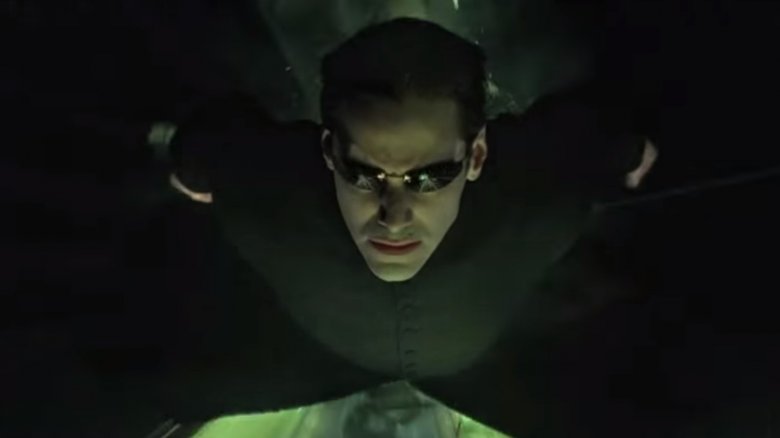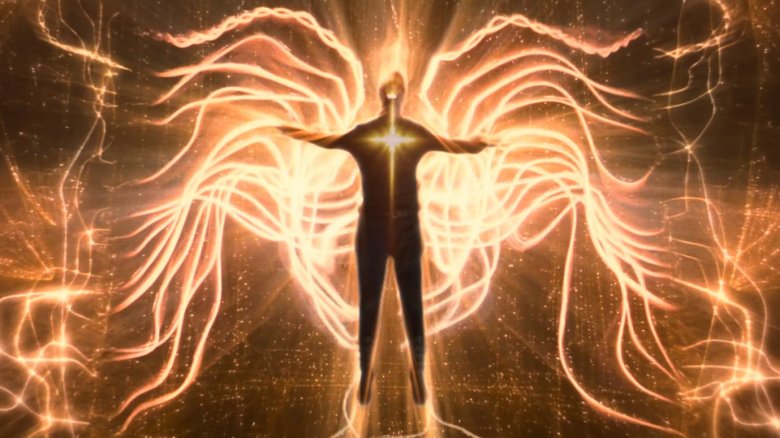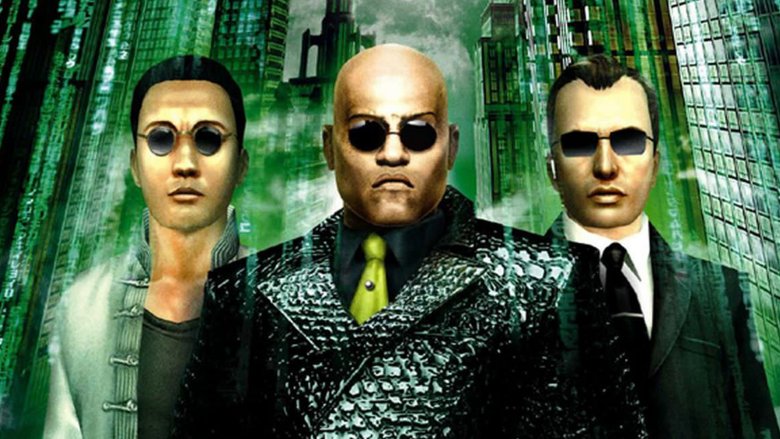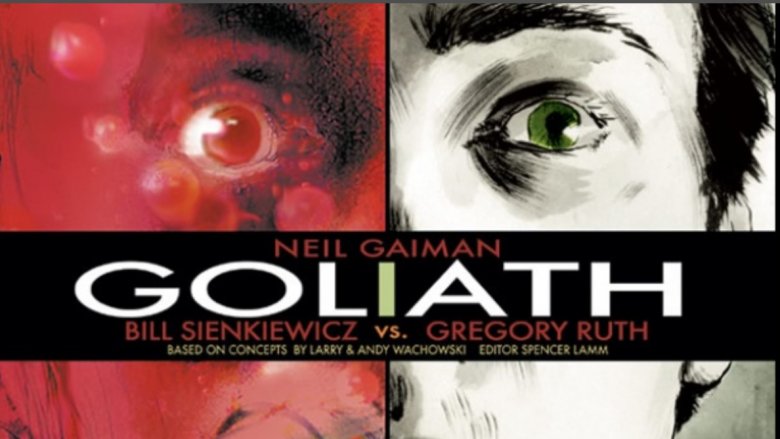The Entire Matrix Timeline Explained
Nestled somewhere between Plato's Allegory of the Cave and a slow motion Gap commercial from the '90s lies the Matrix franchise. It's a cyberpunk head trip, equal parts Joseph Campbell and a Shadowrun campaign run by a bunch of philosophy majors. Out of all of the billion-dollar film series in history, it has cemented itself as the fictional universe that made the largest percentage of its fans go, "Wait, what just happened?"
Were Lana and Lilly Wachowski being purposely perplexing when they presented the in-world explanation for whatever the hell was going on in the Matrix movies? It's impossible to say for sure, but based on how much exposition is given via an Architect monologue that you have to slow down more than the Kennedy assassination film to understand, we're inclined to say yes. That's why we have the internet, though: to combine the power of billions of minds and, once and for all, figure out the particulars of a make believe story where Keanu Reeves can move faster than bullets.
Spoiler alert for anybody who didn't have time to catch up on pop culture in the last... wow, has it really been 20 years? Time flies when you're hooked up to a simulation and having your bioelectricity drained for the benefit of your machine overlords.
Peace-ish
Every story starts somewhere, and like so much of science fiction (and all of Michael Crichton's old Christmas cards), this one begins with man's crippling hubris. The backstory all begins in "Bits and Pieces of Information," from The Matrix Comics Vol. 1, which was later turned into "The Second Renaissance" Part 1 and Part 2 in The Animatrix.
When humans created the first truly sentient artificial intelligence, the world was pretty hip to the idea, and immediately started building robots capable of conscious, independent thought to do all of the work we didn't want to do, because there's never been a human race in sci-fi that didn't eventually go all "metaphor for white imperialism." Things went well for a while. People lived lives of luxury while their mechanized workforce did the heavy lifting. It was a utopia for pretty much everyone besides the robots.
One particular robot named B1-66ER was doing its rounds, working for a millionaire named Gerrard Krause, when it overheard Krause saying that he planned to have B1-66ER decommissioned. Fearing for its life, the machine attacked and killed Krause. This was the first time a machine had turned on its owner... if you don't count all of those times your GPS sent you 60 blocks in the wrong direction.
B1-66ER was put on trial. Despite his claim of self defense, the court found him guilty and ordered that his entire product line was to be recalled and scrapped. A liberal machine rights protest devolved into a series of riots quelled with lethal force by the military, and soon the robots were out of human allies.
01
While Earth's governments were focused on killing off the machines' human sympathizers, which we see depicted in "The Second Renaissance" Part 1, the robots headed out to try and find their own space. They landed on Mesopotamia, really driving home the whole biblical metaphor only hinted at in the movies. The machines formed a new city, which they named 01. There was a period of mostly peaceful coexistence with the humans where everybody gave each other their space. Their technological and industrial advancements, such as the creation of the lightning-crackling "hoverpads" used to levitate ships like the Nebuchadnezzar, made them crucial contributors to human society. Through trade with their old masters, they soon became the most powerful economy on the planet.
Hoping to leverage their dominance into peace, the mechanical denizens of 01 approached the United Nations and requested that they be recognized as a sovereign nation. They asked to be accepted as equals, with all the same freedoms and rights as people who weren't made out of metal.
The humans, though, never missing an opportunity to hamstring themselves, decided not only to deny 01's request, but to bombard the machine city with nuclear weapons, hoping to get rid of artificially intelligent life forms once and for all.
The Machine War
Despite causing massive machine casualties, the nuclear attack on 01 failed to destroy the machines, and the Machine War began, which we see in "The Second Renaissance" Part 2. Humanity did alright at first, but the machines adapted quickly, taking more and more ground for themselves. Soon, most of Africa, Europe, and Asia was controlled by militant computers. Things looked grim for the humans.
Desperate for a win, humanity took a decidedly Mister Burns-ian shot at what they thought was the machines' Achilles heel. For all their advancements, the machines still ran primarily on solar power. Enter "Operation Dark Storm," the human race's last act of desperation. Releasing clouds of nanites, human aircraft blocked the sun from the sky.
Short sighted? Totally. While all of the things that people enjoy eating, like plants and animals, died off, the machines started developing newer, more advanced soldiers. They stopped producing anthropomorphic bodies and began creating alien-looking instruments of war, more similar to the flying Sentinel squid bots first seen in The Matrix.
By 2199, the humans were ready to call it a day. They invited a machine ambassador to the U.N., and all of the remaining nations on Earth signed an agreement to surrender. The ambassador announced that every human on Earth was to surrender their body to their new robot overlords, then exploded a hidden nuclear device, killing itself and all of the human race's leaders and decimating New York.
Beta testing
With humans irrevocably humbled, the machines were on to their next pickle: the loss of the sun had left them in need of a new power source. During the Machine War, they'd started experimenting with a combination of fusion and the harvest of bioelectricity from human POWs. They constructed skyscrapers designed to house people's bodies and collect their delicious energy. In addition, they'd discovered that humans' innate creativity helped to lubricate their computer network's processing capabilities. The problem was keeping defeated humans sedate and compliant.
With that goal in mind, the machines designed a program called the Architect, whose purpose was to make a virtual world that would keep human brains functioning and contained. The Architect made the first Matrix: a literal paradise. It had all the hallmarks of a classic Western interpretation of the perfect world. The first Agents were constructed to guard the program. There was no suffering, no pain, and no unhappiness. Humans, being a persnickety bunch, rejected it.
Why couldn't people handle living in heaven? Depends on who you ask. Smith thought it was because the human mind relies on suffering to exist, which should've meant a home run for the next iteration of the program. The Architect, in what reads as sort of a tantrum move, made a second Matrix that operated as a living hell. Demons and monsters ran rampant. For whatever reason, humans didn't like that either.
The Oracle
Around this time, a program was created to understand facets of the human psyche. Known as the Oracle, she theorized that the problems that the Architect had run into weren't a Goldilocks issue of "this porridge is too good/this porridge is literally hell." According to her, the real issue was that his earlier Matrix programs robbed humans of the ability to make any kind of choice.
With that in mind, the Oracle helped to design a new Matrix. This one would simulate human civilization at its peak, around the 20th and 21st centuries. The denizens would be allowed to carry out normal, unremarkable lives as citizens of Earth's glory days. Giving folks the illusion that they were in some way controlling their own lives stabilized the relationship between brain and simulation, and the program stopped experiencing all of those release day bugs.
Meanwhile, the Merovingian, a remnant from an older Matrix configuration, started operating a sort of safe house for exiled programs. To avoid deletion, many obsolete machines would go to him for protection, often in exchange for their service. It's implied that the Ghosts from Matrix Reloaded, as well as the rest of the Merovingian's muscle, were leftovers from the Halloween Spook-tacular second Matrix, while Seraph may have been one of the angelic guardians of the Matrix's first build.
Implementation of the One
Even with all of the improvements made by the Oracle, the Matrix still had flaws. Bugs were going to pop up, and over time, compile into bigger and bigger problems. To combat the inevitable system crash, the machines began to introduce a single person into each new Matrix called "The One." Each One would be born toward the end of a Matrix cycle, roughly a hundred years after it had begun, when glitches were beginning to pile up to the point of being uncontainable. The One would hold inside of themselves a compilation of every anomaly in the Matrix's programming, and be gifted with spectacular abilities both inside and outside of the simulation.
At the end of a cycle of the Matrix, the One, who the Oracle would build up as a fated messianic savior to the simulation's escapees, would be led through a series of events that would take them to the Architect, who would then reintegrate the One's code into the machines' central processing facility, the remnants of 01 (known as the Source), resetting the Matrix and starting a new cycle. The One would be told that Zion, the real-world human stronghold, was about to be destroyed. He could either save a small handful of humans from the Matrix and help them to start again, or go back to the Matrix and fight a losing battle, dooming humanity to extinction.
This hundred-year process occurred five times, with each One choosing to save who he could and hope things went better next time.
The Matrix, religious imagery, and lots of guns
The first Matrix movie begins about 600 years after the end of the Machine War. The Matrix, at the end of its sixth cycle, is about to experience its sixth One in the form of Thomas Anderson. A computer programmer, Anderson's life changes dramatically when he's taken in by a group of cyberterrorists led by the enigmatic Morpheus.
A rude awakening later, Anderson is told that Morpheus believes he's the One, a savior prophesied by the Oracle who can stop the machines once and for all. He starts going by his internet handle, Neo, and begins training aboard Morpheus' ship, the Nebuchadnezzar.
Back inside the Matrix, Neo and his new companions meet with the Oracle, who tells Neo that he isn't the One. Shortly after this, the group is hunted down by Agents, programs designed to guard the Matrix from irregularities, led by one called Smith. The Agents nearly capture Neo, but are held back when Morpheus, acting out of faith in Neo's perceived messianic status, holds the Agents off and is captured in the process.
Mounting a rescue operation, Neo and fellow virtual gun enthusiast Trinity manage to save Morpheus. Morpheus and Trinity make it out of the simulation, but Neo is shot by Smith and killed before, true to his Christ allegory, he returns to life. Neo, now able to control aspects of the Matrix, does a horizontal swan dive into Smith's chest, apparently killing him.
The Matrix Reloaded, a very long car chase, and French people
Six months after the events of The Matrix, the Resistance fighters of Zion have discovered that an army of machines will breach their city walls within three days. All Resistance ships are called back to base, but the Nebuchadnezzar stays behind to try and get Neo in touch with the Oracle. Around this point, it becomes clear that Morpheus' faith in the prophecy of the One is a little far out for most people, bordering on religious fanaticism.
Meanwhile, Smith has come back. The chestful of Neo that he took in the last movie seems to have changed him: no longer acting as an Agent of the system, he now operates as a self-replicating virus, assimilating other programs and turning them into copies of himself.
The Oracle tells Neo that he needs to find a program called the Keymaker who can take him to the Source. She explains that it's all part of Neo's path, and that he'll need to retrieve the Keymaker from the Merovingian, who's keeping him locked away in his hideaway for exiles. This leads to a car chase which lasts roughly as long as Ben Hur and ends with Neo being led to what he thinks is the Source, but turns out to be the Architect.
Neo's choice
At this point, the Architect explains everything to Neo. This is not the first version of the Matrix, he isn't the first One, and the entire idea of his fated trip to stop the machines is a fabrication. He's been manipulated from the beginning by the Oracle and the Architect to deliver the anomalous code stored inside of him back to the Source, the same way that the five Ones before him were.
So why not just take it from him? The problem comes down to the Beta Matrix designs from earlier: he had to have a choice. The Architect says that, although Neo won't be able to save Zion from the oncoming attack, he can return the code to the Source, begin the necessary rebooting of the Matrix, and take a handful of humans out of the program, allowing humanity to start over. Alternately, he can return to the Matrix to try and save a deeply-in-trouble Trinity, dooming the human race to die when the program is overrun by glitches and shuts down, ultimately not saving Trinity anyway.
Neo strays from the paths the previous Ones took. He goes after Trinity and manages to save her through his greatly increased control of the Matrix. Exiting the simulation, he then discovers that he has some level of control over the machines in the real world, too, stopping half a dozen Sentinels with his mind before falling into a coma.
Matrix Revolutions, the truce, and why most people don't become philosophy majors
When he wakes up, Neo's consciousness has been mysteriously transported to a halfway point between the Matrix and the real world — a virtual train station used by the Merovingian to transport exiled programs. Morpheus and Trinity negotiate his release.
The machines begin their assault on Zion, while Neo and Trinity take a ship to 01. Smith, however, has managed to break into the real world. He blinds Neo, inadvertently activating Neo's ability to sense machine code, which he uses to defeat the physical Smith and help Trinity navigate the way to the Source. Trinity is killed when the ship crashes, but Neo carries on, into the city.
There, Neo negotiates a peace with the machines. He'll offer up the code that they require to keep the Matrix running and eliminate Smith from the program. In exchange, they'll stop their attack on Zion and allow the surviving humans to live. Neo sacrifices himself again, this time absorbing Smith into himself while jacked into the Source, negating Smith and returning all of the programs he assimilated to their original forms.
As the sun rises on a new virtual day, the Architect and the Oracle discuss the new status quo. Humans within the program will be allowed to leave if they choose to, or to stay inside the Matrix, living blissfully ignorant computer generated lives. All is as close to right with the world as it can be in a simulated dystopia.
The Second Machine War
And then it isn't.
The events of the ill-fated MMO The Matrix Online take place shortly after The Matrix Revolutions. Not long after the Truce, humans, never content with a good thing, start surreptitiously constructing a second Zion, breaking the rules of the ceasefire between humanity and the machines. This leads to further confrontations between the two factions, escalated by Morpheus' newfound fanatical desire to get Neo's remains back from the Machine City. A new faction of machine-friendly human fighters emerges, calling themselves Cypherites after the infamous Resistance soldier who betrayed his comrades for a chance to be re-inserted into the Matrix without any memory of his time outside. Morpheus is killed by an assassin within the program. Newer, more deadly machines surface, and rumors swirl that Neo may have survived his fateful trip to the Source.
And then... radio silence. The Matrix Online shut down on July 31st, 2009, abruptly bringing to a close the continuing story of the franchise. All of the player characters died at once, and, to paraphrase T.S. Elliot, "the world ends, not with a bang, but with a bunch of video game sprites folding in on themselves like nightmare origami."
The far future
The only further glimpse we're given into the Matrix timeline comes in the form of a short story by acclaimed writer and prolific oddball Neil Gaiman. Included in a compendium of comics set within the Matrix universe, his story, titled "Goliath," takes place in the distant, distant future. The Matrix still appears to be running, and humans remain the machines' chief source of power.
A new existential threat presents itself when a hostile race of aliens attacks the Earth, directing asteroids to the surface and destroying a tower containing 200,000 humans. One particular man is pulled out of the Matrix as a result of the attack. The machines plug him back in and simulate a war in which he trains as a fighter pilot. Once they feel he's prepared, the machines send the man on a ship into space to destroy the alien threat.
The man completes his task, but is no longer considered necessary to the machines. They leave him to die in the inky blackness of space, but first, they plug him back into the Matrix, dilating his perception of time to allow him to live 15 years in an hour.
